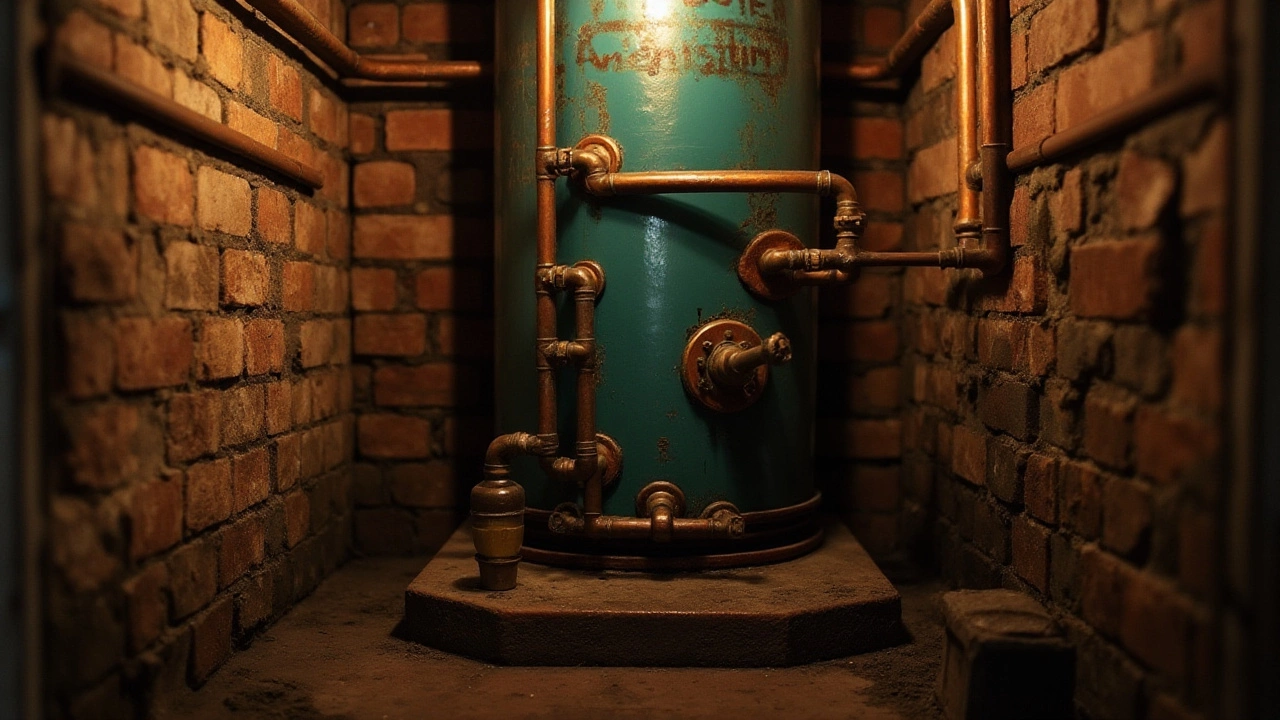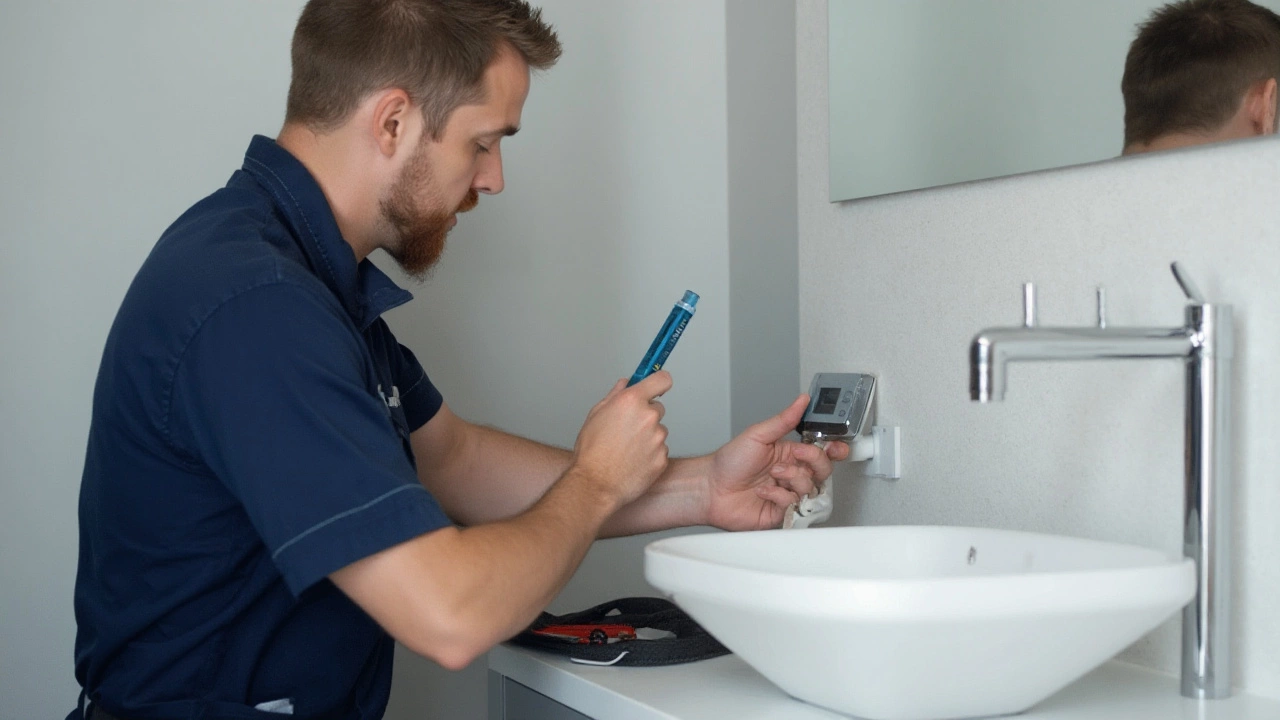There's nothing quite like stepping into the shower only to be jolted awake by freezing water. When your hot water flees the scene without notice, it can throw a wrench into your day's plans. But before you throw in the towel and call the repairman, let's dive into some possible reasons why your hot water heater might not be cooperating.
Whether it's a grumpy thermostat that needs a nudge, sediment that's silently plotting in the tank, or more, knowing a bit about how these systems tick can save you both time and money. In this guide, we're breaking down the usual suspects behind the loss of hot water, offering DIY tips for those who like to roll up their sleeves, and sharing preventative advice that keeps such mishaps at bay. Let's ensure you'll have that hot shower sorted without unnecessary delay.
- Understanding Your Hot Water Heater
- Common Reasons for Hot Water Failure
- DIY Troubleshooting Tips
- Maintenance Tips to Prevent Issues
- When to Call a Professional
Understanding Your Hot Water Heater
From ancient bathhouses to modern-day showers, humans have always sought the comfort of hot water. Yet, understanding how your hot water heater operates requires a dash of curiosity and a basic grasp of plumbing wizardry. These stout, unsung heroes of household comfort come in various shapes and sizes, including the dependable storage tank models and the efficient tankless systems that wait in the wings to heat water on demand. A typical storage tank heater holds around 30 to 50 gallons, steadily maintaining heat through a series of intricate components. Just imagine it as a large insulated reservoir where cold water enters and is greeted by electrical elements or gas burners that stoke the internal temperature to a cozy 60°C (140°F). This delicate balance of heat is crucial, ensuring that hot water is always ready when a tap is turned.
The magic begins with the thermostat—a thermostat acting as the conductor of a symphony, silently orchestrating everything to maintain that perfect hot water temperature. It sends signals instructing the heating elements to leap into action and heat the incoming cold water. But it's not all about heat. Cold water enters through a dip tube, diving into the depths to ensure an even heating process. At the same time, the hot water, lighter and bubbling up, is pushed out through the heat-out pipe, ready to tackle your household chores. A marvel, isn't it?
In a world where energy efficiency is king, many homes embrace the tankless system, which promises to heat water with startling immediacy. This system skips the middleman, transporting water through a unit where high-powered burners or electric coils instantly raise its temperature. With market forces and climate awareness guiding choices in water heating, innovations focus on delivering hot water that is as efficient as it is effective. According to the U.S. Department of Energy, tankless heaters typically use 24% to 34% less energy for homes that use 41 gallons or less of hot water daily. In larger households, the savings still hover between 8% to 14%, showcasing a delightful convergence of technology and sustainability so sought after today.
The Vital Role of Regular Maintenance
Understanding the need for regular maintenance is just as critical as knowing how your heater ticks. One should regularly check the sacrificial anode rod—a hero in its own right that prevents corrosion by sacrificing itself to rust. Without this martyr to protect the tank, your heater's lifespan may be drastically shortened. Another crucial point is sediment buildup, a stealthy nemesis that can lead to inefficient heating and, ultimately, hotter water bills.
"A regular maintenance schedule can prevent up to 90% of the issues homeowners face with their water heaters," states The International Association of Certified Home Inspectors.
Armed with this knowledge, you gain an empowering grip over your water heater, ensuring not only that you can address problems when they arise but also that you can extend the lifespan of your trusty appliance. By engaging with these steps, you not only enrich your home comfort but also contribute to a more sustainable and energy-efficient future, exemplifying the formidable marriage of human ingenuity and modern convenience.
Common Reasons for Hot Water Failure
Finding yourself without hot water can be a vexing ordeal, especially at the peak of rush hour as you scramble to prepare for the day. A solid grasp of the typical causes of hot water heater malfunctions can be your first step toward resolving the issue calmly. Let's delve into some of the leading causes of these unwelcome cold spells and how you can identify them.
A primary suspect in the case of disappearing hot water is a faulty thermostat. Often tucked away in the world of wires and controls, the thermostat is responsible for regulating the water temperature. If it malfunctions, you might find that your water is consistently lukewarm or icy. This problem often masks itself as a minor hiccup, but the solution might require a simple readjustment or a full replacement, dependent on the model.
Beyond the thermostat lies the accumulation of sediment at the bottom of the water tank, especially in older units. This all-too-common issue can disrupt the heating process, as layers of sediment settle and form an insulating barrier between the burner and the water. The harder your water, the more mineral deposits will accumulate. Regularly flushing your tank is essential maintenance to prevent sediment buildup, allowing your water heater to operate at full capacity without the risk of an unforeseen cold shower.
The water heater's pilot light or electric ignition serves as its heartbeat. If this gets extinguished, the water heater won’t fire up. Gas heaters often rely on a delicate flame, while electric models use ignition systems. Failure in these components doesn't mean you're out for good; sometimes, it's as simple as relighting the pilot light according to the manufacturer's instructions or checking for tripped circuit breakers in electric models.
Consider the surrounding environment of your water heater as well. Spaces like basements are prone to cold temperatures, which can subsequently affect the performance of your heater. Insufficiently insulated pipes can lead to heat loss during transfer. Insulating your pipes not only mitigates this issue but also enhances the overall efficiency of your hot water system.
Plumbing problems can play their part too. Leaks in the hot water system siphon away the warm water before it reaches your faucet. A quick inspection around the plumbing lines can oftentimes reveal a water stain or a persistent leak, guiding you on where to focus your repairs. In this journey of restoring your hot showers, remember you're not alone.
According to the Energy Efficiency and Renewable Energy division of the U.S. Department of Energy, regular maintenance procedures such as tank flushing and thermostat adjustments can extend the life of your water heater and cut energy costs significantly.
Armed with this knowledge on the hot water issues typifying malfunctioning heaters, you'll be better equipped to identify and possibly fix problems before they snowball into full-blown replacements. Diligence with basic upkeep and timely intervention can spell the difference between icy plunges and comforting cascades of warmth.

DIY Troubleshooting Tips
Embarking on a mission to diagnose a stubborn hot water heater can feel daunting, but it doesn't have to be. Embrace your inner detective as we explore practical steps that can be taken from the comfort of your home. Before diving into a repair, it's helpful to understand basic components of a water heater and common issues that may halt its operation. Sometimes, a small tweak or adjustment can work wonders in restoring that precious flow of hot water.
First, inspect your circuit breaker or fuse box. In some cases, all it takes is a simple flip of a switch if it's been tripped accidentally. Another possibility could be the appliance reset button, typically found on the water heater's thermostat. Press it, and you might be back in business. If the reset yields no result, it may be time to inspect the thermostat. Be sure the settings align with recommended temperatures or consider replacing a malfunctioning unit.
The U.S. Department of Energy suggests, 'For every 10ºF reduction in temperature, you can save between 3%–5% on energy costs.'
Mineral buildup in the tank is a silent but persistent adversary of efficient water heating. Draining the tank every six months can help prevent sediment accumulation, allowing your heater to function smoothly. To do this, turn off the power supply and water source, connect a garden hose to the drain valve, and let the tank empty. Watch the water draining; if it's rusty or muddy, a regular flush may be in order to prevent future surprises.
Identifying Leaks and Drips
Leaks can spring up in unexpected places, and it's important to check both the surrounding area and water lines for any signs of dripping. Examine the pressure relief valve which, when faulty, can lead to drips and hissing noises. Tighten connections as necessary, or replace worn-out parts to keep things dry. Going through the manufacturer's manual can provide additional clarity on replacing parts, tailored to your specific model.
Hot water issues often boil down to a series of smaller, manageable problems. With a little careful investigation, many homeowners can tackle these fixes themselves. Of course, if all else fails and the heater remains uncooperative, it might be time to seek professional assistance — especially when dealing with gas-powered units. Safety always comes first, and for some tasks, professional experience cannot be replaced.
The heart and soul of plumbing problems revolve around persistence and patience. As with any troubleshooting adventure, documenting your steps can help track progress or pinpoint precisely where the issue may need an expert's touch. Armed with a bit of knowledge and some hands-on effort, finding a solution becomes a satisfying experience, leaving you with a well-deserved and steamy hot shower.
Maintenance Tips to Prevent Issues
Maintaining your hot water heater not only ensures a steady supply of hot water but also extends the appliance's life, saving you from potentially costly repairs. A regular maintenance routine can prevent common issues like sediment buildup, faulty thermostats, and water leaks. If you pay attention to your water heater repair needs, chances are you'll enjoy fewer disruptions and better efficiency.
One of the most effective ways to maintain your hot water system is by flushing the tank. Sediment can accumulate over time, reducing the heating efficiency, and potentially damaging your heater. Flushing involves draining the tank fully and then refilling it, usually done once or twice a year. This seemingly simple act can significantly improve the performance of your heater. It may sound daunting, but with the right tools and a little patience, it's no more difficult than your routine gardening. Additionally, adjusting your thermostat to a moderate temperature – typically around 120 degrees Fahrenheit – not only helps cut down on utility costs but also lessens wear and tear on the heating element.
You can add an extra layer of protection to potentially problematic areas by installing expansion tanks or pressure relief valves. These components manage the extra pressure that builds up when water expands as it is heated, preventing strain on the heater and pipes. Keeping an eye out for leaks, rust, or corrosion can steer you clear from emergencies. Often, a quick visual inspection can save you from hefty repair bills. In fact, the Department of Energy indicates that simple water heater maintenance tips like these can reduce standby heat losses and extend the heater's lifespan by up to 50%.
"Regular maintenance is the key to avoiding unexpected breakdowns and ensuring optimal performance," says Jane Marshall, a veteran plumber of 30 years. "Don’t wait until there's a problem. A little upkeep can go a long way in maintaining your water heater's health."
Don't forget the power of a professional tune-up. An annual check-up by a qualified plumber can unveil hidden issues and calibrate components to work efficiently. While DIY efforts are always commendable, professionals have the tools and expertise to delve deeper and provide assurance that your systems are ship-shape. Understanding your water heater’s particular needs based on its model and age is crucial. Older models might benefit from more frequent inspections, while tankless heaters have their own unique set of requirements.
Remember, even in temperate climates like pre-mountain Wellington, New Zealand, neglecting maintenance can lead to a cold shower surprise. It only takes a bit of routine care to keep your water heater singing in tune and your home brimming with hot water. Implement these maintenance techniques and enjoy peace of mind knowing that your system is running smoothly and efficiently.

When to Call a Professional
Sometimes, despite your best efforts, trying to figure out what's wrong with your hot water heater can be like opening a can of worms. However, knowing when to throw in the towel and bring in a professional can save you more than just frustration—it can prevent potentially disastrous outcomes. For instance, if you hear unusual noises like banging, screeching, or popping from your unit, it's typically a sign of significant underlying issues such as sediment buildup or pressure inside the tank. Such cases require a seasoned expert to safely diagnose and fix the problem.
Another red flag is if there's visible water leaking from the water heater. This is not just a mess on your floor; it signifies that the tank may be corroding internally, which could lead to a catastrophic failure. Attempting any DIY fixes without adequate plumbing expertise could worsen the situation and turn minor leakage into a flood. Temperature issues too, like water that's either too cold or too hot, often point to thermostat or heating element malfunctions—areas where specialized skills and tools are usually necessary for repairs.
Complex Repairs
There are certain aspects of water heater repair that most homeowners simply won't have the tools or expertise for handling. For instance, gas water heaters, with their intricate relationship of valves and thermocouples, require caution and precision. Tinkering carelessly could lead to gas leaks or cause the unit to malfunction even more. Perplexing electrical issues in electric heaters demand similar respect; a professional's meticulous touch can safely root out the fault, avoiding any unfortunate shocks or fires.
Some newer models of water heaters also come equipped with digital displays that can show error codes when things go awry. While this makes troubleshooting simpler, those codes often need interpretation beyond a quick internet search. Specialists are familiar with each make and model, able to act swiftly and efficiently. Besides the technical aspects, certified plumbers or specialists offer peace of mind; their expertise ensures your family’s safety and preserves home infrastructure.
Preventive Maintenance
"An ounce of prevention is worth a pound of cure," as Benjamin Franklin wisely put it. Regular check-ups conducted by professionals can extend the lifespan of your hot water system and mitigate the chances of sudden breakdowns.
Annual maintenance checks conducted by licensed plumbers can identify potential issues before they become significant headaches. This might include flushing out accumulated sediment in the tank, testing key components like the pressure relief valve, or adjusting the settings for optimal performance. Many service providers offer plans that come with periodic inspections, which might seem like an upfront cost, but save money in the long run by preventing costly repairs or replacements.
Moreover, professionals keep your heater compliant with the recommended regulations and standards, ensuring safety leads the way. So, while it’s admirable to tackle what you can, knowing when to pick up the phone will serve your plumbing problems well. After all, some tasks are better trusted to those trained and ready to face whatever challenge comes piping their way.

